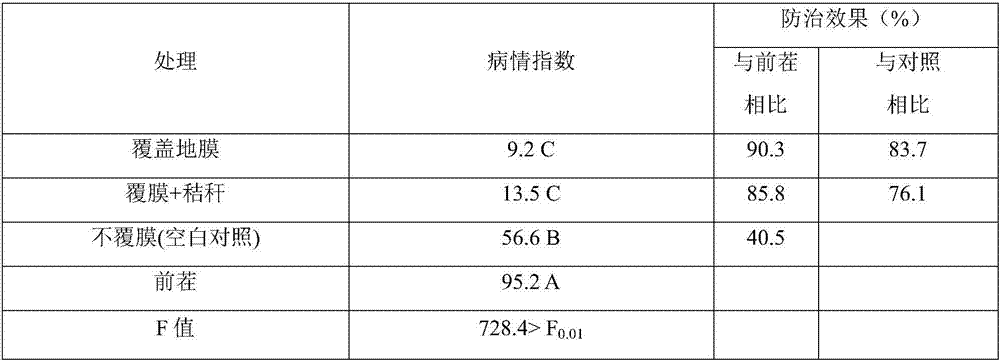Method for preventing solar greenhouse root-knot nematode disease
A root-knot nematode disease and solar greenhouse technology, applied in botany equipment and methods, horticulture, plant protection covers, etc., can solve problems such as low quality of agricultural products, achieve the effect of slowing down nematode resistance, high control efficiency, and easy operation
- Summary
- Abstract
- Description
- Claims
- Application Information
AI Technical Summary
Problems solved by technology
Method used
Image
Examples
Embodiment 1
[0022] From July 15th to August 11th, 2010, smothering was carried out during the period when the greenhouse was closed. Under the condition that the shed film used the old shed film used in the previous stubble and the straw curtain was not covered at night, a total of 3 treatments were set up and repeated three times. A total of 9 plots with an area of 40m 2 .
[0023] Treatment 1: Deep plow the soil first, and then 400kg / 667m of straw 2 After application, use a rotary tiller to mix it with the soil, then cover it with plastic film, then fill it with sufficient water, and seal the shed for 25 days.
[0024] Treatment 2: Dig the soil deeply first, then cover with mulch without applying straw, then fill with sufficient water, and seal the shed for 25 days.
[0025] Treatment 3: blank control, deep plowing of the soil first, no application of straw and no mulch film, only enough water, and airtight greenhouse for 25 days.
[0026] 1. Temperature measurement
[0027] Table...
Embodiment 2
[0037] In 2011, the smothering conditions were optimized and tested again. During the period from July 20 to August 13, 2011, when the greenhouse was closed, three treatments were set up under the condition that the film was replaced, the straw curtains were covered from 19:00 to 8:00 the next day, and the straw curtains were drawn at 8:00 am. Three repetitions, a total of 9 plots, with a plot area of 70.8m 2 .
[0038] Treatment 1: Deep plow the soil first, and then 400kg / 667m of straw 2 After application, use a rotary tiller to mix it with the soil, then cover it with plastic film, then fill it with sufficient water, and seal the shed for 25 days.
[0039] Treatment 2: Dig the soil deeply first, then cover with mulch without applying straw, then fill with sufficient water, and seal the shed for 25 days.
[0040] Treatment 3: Blank control, no straw application, no mulching film, only enough water, airtight greenhouse, last 25 days
[0041] 1. Temperature measurement
...
PUM
| Property | Measurement | Unit |
|---|---|---|
| Width | aaaaa | aaaaa |
Abstract
Description
Claims
Application Information
 Login to View More
Login to View More - R&D
- Intellectual Property
- Life Sciences
- Materials
- Tech Scout
- Unparalleled Data Quality
- Higher Quality Content
- 60% Fewer Hallucinations
Browse by: Latest US Patents, China's latest patents, Technical Efficacy Thesaurus, Application Domain, Technology Topic, Popular Technical Reports.
© 2025 PatSnap. All rights reserved.Legal|Privacy policy|Modern Slavery Act Transparency Statement|Sitemap|About US| Contact US: help@patsnap.com



